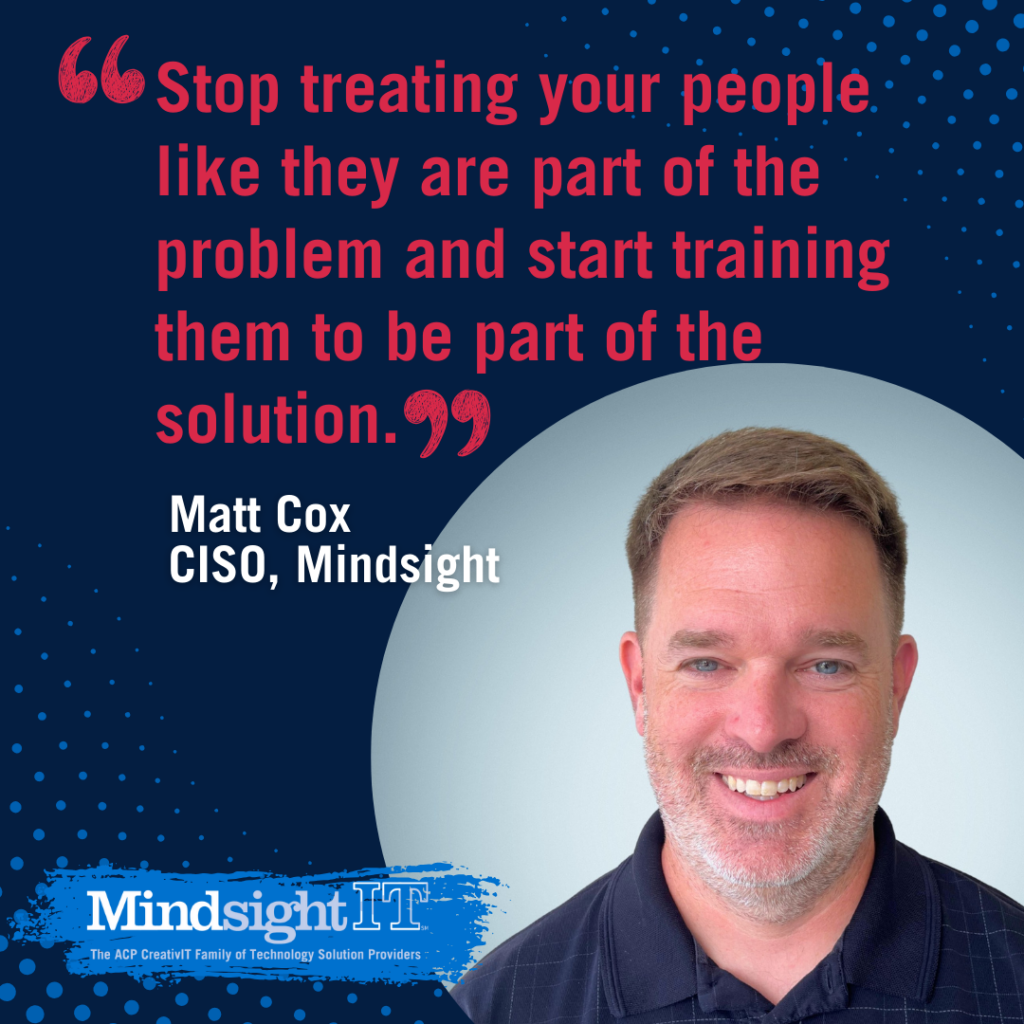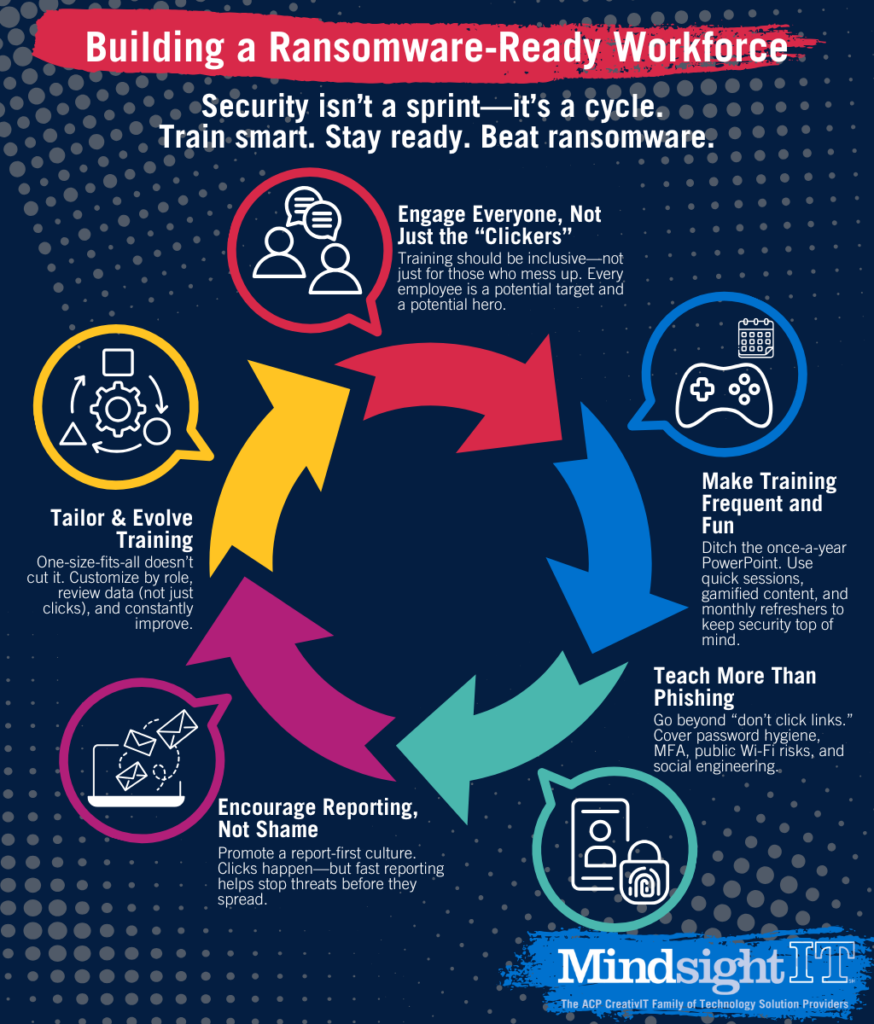April 1, 2025
If you think the biggest threat to your organization is some hoodie-wearing hacker pounding away at a keyboard in a dark basement, think again. The real danger? A distracted employee who clicks the wrong link in an email while rushing between meetings. That’s how ransomware sneaks in, which is why training your people is one of the most important things you can do to stay safe.
Whether you’re running a company, a school district, or a government office, the message is the same: Ransomware readiness starts with your team. And unfortunately, most training programs just aren’t cutting it.
“Stop treating your people like they are part of the problem and start training them to be part of the solution,” says Mindsight’s Matt Cox. From Integrating Cybersecurity into Your C-Suite to creating a cybersecurity culture Mindsight shares the elements necessary to keep your network safe.

Phishing Emails Are the Front Door to Ransomware
Most ransomware attacks start with something simple: a phishing email. It looks innocent. Maybe it says it’s from the boss. Maybe it’s a fake invoice. One click later, and suddenly your data is encrypted, your network is in chaos, and you’re the subject of a very serious Zoom meeting.
That’s why training matters so much. Because it’s not just about technology. It’s about people knowing how to spot shady stuff before it becomes a disaster.
Click Rates Are Not the Holy Grail
A lot of security programs love to brag about low phishing “click rates.” But here’s the thing: click rates are easy to manipulate. Want to make it look like no one’s falling for phishing? Just send out an obviously fake email, like one from a “Nigerian Prince” promising you a yacht.
Instead of obsessing over who clicked, focus on who reported the phishing attempt. Reporting is what actually helps stop a real attack in its tracks. If your team is quick to flag suspicious emails, they’re doing exactly what you want them to do.
Training Shouldn’t Be a Snoozefest
You know what doesn’t work? One long, boring training session once a year. People zone out. They forget everything two weeks later. And let’s be honest, no one remembers that PowerPoint about password hygiene from last March.
Effective training is short, regular, and actually engaging. Think quick videos, interactive quizzes, even a little friendly competition. Got departments? Create a leaderboard. People love seeing how their team stacks up, especially if there are bragging rights on the line.
Don’t Just Train the “Clickers”
A big mistake? Only training the people who mess up and click on phishing emails. That’s like giving swim lessons only to the folks who fell in the pool. Everyone needs to be in on the training, not just the people who slipped up.
And stop treating employees like they’re the problem. They’re not. They’re your first line of defense. When they’re confident and informed, they make smarter choices. Whether it’s recognizing a phishing email, avoiding sketchy Wi-Fi, or using strong passwords, trained employees are security assets.
One Size Doesn’t Fit All
Different people face different risks. Your software developers, help desk crew, and leadership team all deal with different kinds of threats. So why give them the same training? Mix it up. Tailor your content. Make it relevant to their roles and they’ll actually pay attention.
If you’re in a smaller organization, that’s okay, too. Start simple, train consistently, and keep it fresh. Even 10 minutes of training a month can pay off in a big way.
Ransomware Doesn’t Wait, So Don’t Wait to Train
Cybercriminals are getting smarter, faster, and sneakier. And now they’re using AI to craft scarily convincing phishing emails. It’s not a matter of if your organization gets targeted. It’s when.
So ask yourself: when that moment comes, do you want an unprepared team that panics? Or a crew that spots the danger, reports it, and shuts it down before it spreads?
Your best defense isn’t just firewalls and fancy tools. It’s people who know what to do.
TL;DR
- Ransomware starts with people, so train your people.
- Don’t just track click rates. Encourage reporting.
- Make training engaging, not exhausting.
- Train everyone, not just the folks who slip up.
- Keep it regular, relevant, and role-specific.
Because when the next phishing email hits someone’s inbox, it won’t be your antivirus making the call. It’ll be a person. And if that person is trained and ready, you’re already winning.

About Mindsight
Mindsight delivers enterprise managed services and technology solutions to the mid-market across a variety of industries including manufacturing, financial services, government, education – just to name a few. Our solution architects and engineers are 100% expert-level and work as an extension of your IT team. Mindsight is headquartered in Downers Grove, IL, a suburb of Chicago.
Mindsight is part of the ACP CreativIT Family of Technology Solution Providers